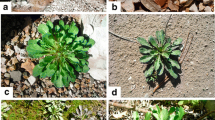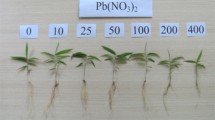Abstract
Due to health reasons, toxic metals must be removed from soils contaminated by mine tailings and smelter activities. The phytoremediation potential of Prosopis pubescens (screw bean mesquite) was examined by use of inductively-coupled plasma optical emission spectroscopy. Transmission electron microscopy was used to observe ultrastructural changes of parenchymal cells of leaves in the presence of copper. Elemental analysis was used to localize copper within leaves. A 600-ppm copper sulfate exposure to seedlings for 24 days resulted in 31,000 ppm copper in roots, 17,000 ppm in stems, 11,000 in cotyledons and 20 ppm in the true leaves. For a plant to be considered a hyperaccumulator, the plant must accumulate a leaf-to-root ratio <1. Screw bean mesquite exposed to copper had a leaf-to-root ratio of 0.355 when cotyledons were included. We showed that P. pubescens grown in soil is a hyperaccumulator of copper. We recommend that this plant should be field tested.









Similar content being viewed by others
References
Ahsan N, Lee DG, Lee S-H, Kang KY, Lee JJ, Kim PJ et al (2007) Excess copper induced physiological and proteomic changes in germinating rice seeds. Chemosphere 67:1182–1193
Aldrich MV, Ellzey JT, Gardea-Torresdey JL, Peralta-Videa JR, Gonzalez JH (2004) Lead uptake effects of EDTA on lead-tissue concentrations in the desert species mesquite (Prosopis sp.). Int J Phytoremediat 6(3):195–207
Aldrich MV, Peralta-Videa JR, Parsons JG, Gardea-Torresdey JL (2006) Examination of arsenic (III) and (V) uptake by the desert plant species mesquite (Prosopis spp.) using X-ray absorption spectroscopy. Sci Total Environ 379:249–255
Arias JA, Peralta-Videa JR, Ellzey JT, Ren M, Viveros MN, Gardea-Torresdey JL (2010) Effects of Glomus deserticola inoculation of Prosopis: enhancing chromium and lead uptake and translocation as confirmed by X-ray mapping, ICP-OES and TEM techniques. Environ Exp Bot 68:139–148
Armstrong DL (1998) Functions of potassium in seedlings. Better Crops 82(3):1–40
Baker AJM (1981) Accumulators and excluders—strategies in the response of seedlings to heavy metals. J Plant Nutr 3:643–654
Baker AJM, Brooks RR (1989) Terrestrial higher plants which hyper accumulate metallic elements—a review of their distribution, ecology and phytochemistry. Biorecovery 1:81–126
Baker AJM, McGrath SP, Reeves RD, Smith JAC (2000) Metal hyper accumulator seedlings: a review of the ecology and physiology of a biological resource for phytoremediation of metal-polluted soils. In: Terry N (ed) Phytoremediation of contaminated soil and water. Lewis, Boca Raton
Baryla A, Carrier P, Franck F, Coulomb C, Sahut C, Havaux M (2001) Leaf chlorosis in oilseed rape seedlings (Brassica napus) grown on cadmium-polluted soil: causes and consequences for photosynthesis and growth. Planta 212:696–709
Blevins DG, Lukaszewski KM (1998) Boron in plant structure and function. Annu Rev Plant Physiol Plant Mol Biol 49:481–500
Borghi M, Tognetti R, Monteforti G, Sebastiani L (2007) Responses of Populus x euramericana (P. Deltoides x P. Nigra) clone Adda to increasing copper concentrations. Environ Exp Bot 61:66–73
Brooks RR, McCleave JA, Schofield EK (1977) Cobalt and nickel uptake by the Nyssaceae. Taxon 26:197–201
Brooks RR, Chambers MF, Nicks LJ, Robinson BH (1998) Phytomining. Trends Plant Sci 3(9):359–362
Burzynski M, Zurek A (2007) Effects of copper and cadmium on photosynthesis in cucumber cotyledons. Photosynthetica 45:239–244
Chaignon V, Hinsinger P (2003) Heavy metals in the environment: a biotest for evaluating copper bioavailability to seedlings in a contaminated soil. J Environ Qual 32:824–833
Clarkson DT, Hanson JB (1980) The mineral nutrition of higher seedlings. Annu Rev Plant Physiol Plant Mol Biol 31:239–298
Demirevska-Kepova K, Simova-Stoilova L, Stoyanova Z, Holzer R, Feller U (2004) Biochemical changes in barley seedlings after excessive supply of copper and manganese. Environ Exp Bot 52:253–266
Gardea-Torresdey JL, Peralta-Videa JR, De la Rosa G, Parsons JG (2005) Phytoremediation of heavy metals and study of the metal coordination by X-ray absorption spectroscopy. Coord Chem Rev 249:1797–1810
Goldbach HE (1984) Influence of boron nutrition on net uptake and efflux of 32P and 14C-glucose in Helianthus annuus roots and cell cultures of Daucus carota. J Plant Physiol 118:431–438
Hu H, Brown PH (1994) Localization of boron in cell walls of squash and tobacco and its association with pectin. Plant Physiol 105:681–689
Ke WS, Xiong ZT, Chen SJ, Chen JJ (2007) Effects of copper and mineral nutrition on growth, copper accumulation and mineral element uptake in two Rumex japonicas populations from a copper mine and an uncontaminated filed site. Environ Exp Bot 59:59–67
Ketterer ME (2006) The ASARCO El Paso smelter: A source of local contamination of soils in El Paso (Texas), Ciudad Juarez (Chihuahua, Mexico), and Anapra (New Mexico). The Sierra Club (Summary Report)
Khan AG, Kuek C, Chaudhry TM, Khoo CS, Hayes NJ (2000) Role of seedlings, mycorrhizae and phytochelators in heavy metal contaminated land remediation. Chemosphere 41:197–207
Marschner H (1995) Mineral nutrition in higher seedlings, 2nd edn. Academic, San Diego
Millaleo R, Reyes-Díaz M, Ivanov AG, Mora ML, Alberdi M (2010) Manganese as essential and toxic element for seedlings: transport, accumulation, and resistance mechanisms. J Soil Sci Plant Nutr 10(4):476–494
Mokgalaka-Matlala, Ntebogeng S, Flores-Tavizón E, Castillo-Michel H, Peralta-Videa JR, Gardea-Torresdey JL (2009) Arsenic tolerance in mesquite (Prosopis sp.): low molecular weight thiols synthesis and glutathione activity in response to arsenic. Plant Physiol Biochem 47(9):822–826
Pätsikkä E, Kairavuo M, Sersen F, Aro EM, Tyystjärvi E (2002) Excess copper predisposes photosystem II to photoinhibition in vivo by outcompeting iron and causing decrease in leaf chlorophyll. Plant Physiol 129(3):1359–1367
Prasad MNV (2004) Heavy metal stress in seedlings: from biomolecules to ecosystems. Springer, India
Quartacci MF, Cosi E, Navari-Izzo F (2001) Lipids and NADPH-dependent superoxide production in plasma membrane vesicles from roots of wheat grown under copper deficiency or excess. J Exp Bot 52:77–84
Rengel Z (2001) Xylem and phloem transport of micro nutrients. In: Horst WJ et al (eds) Plant nutrition—food security and sustainability of agro-ecosystems. Kluwer Academic, Netherlands, pp 628–629
Rhodes D, Felker P (1988) Mass screening of Prosopis (mesquite) seedlings for growth at seawater salinity concentrations. Forest Ecol Manage 24:169–176
Roito M, Rautio P, Julkunen-Tiitto R, Kukkola E, Huttunen S (2005) Changes in the concentrations of phenolics and photosynthates in Scots pine (Pinus sylvestris L.) seedlings exposed to nickel and copper. Environ Pollut 137:603–609
United States Environmental Protection Agency. www.epa.gov. Accessed 1 Oct 2012
Yamanouchi M (1971) The role of boron in higher seedlings. I. The relations between boron and calcium or the pectic substances in seedlings. J Sci Soil Manure 42:207–213
Yamauchi T, Hara T, Sonoda Y (1986) Distribution of calcium and boron in the pectin fraction of tomato leaf cell wall. Plant Cell Physiol 27:729–732
Acknowledgments
This research was primarily undertaken in the Analytical Cytology Core Facility, partially funded by the Border Biomedical Research Center (BBRC), the University of Texas at El Paso, National Institute of Minority Health Disparities (NIMHD Grant No. 8G12MD007592). For copper and nutrient assessment, ICP-OES equipment in the Chemistry Department was used (National Science Foundation Grant No. CHE-0840525 and United States Department of Agriculture Grant No. 2011-38422-30835). This material is based on work supported by the National Science Foundation and the USEPA under Cooperative Agreement No. DBI-0830117. Any opinions, findings, and conclusions or recommendations expressed in this material are those of the investigator(s) and do not necessarily reflect the views of the National Science Foundation or the USEPA. This work has not undergone USEPA review, and no official endorsement should be inferred. J. Jorge Gardea-Torresdey acknowledges the Dudley family for the Endowed Research Professorship in Chemistry. M. N. Zappala received funding from the Howard-UTEP Alliance for Graduate Education Program (HUTEP-AGEP), NSF Grant No. HRD-0832951. Undergraduate students who provided electron micrographs under the supervision of Joanne T. Ellzey included Alma Cortes and Karla Viramontes. Special thanks to Ted Whitworth for his help in obtaining electron micrographs. Contents are solely the responsibility of the authors and do not necessarily represent the official views of the BBRC or the National Institutes of Health.
Author information
Authors and Affiliations
Corresponding author
Rights and permissions
About this article
Cite this article
Zappala, M.N., Ellzey, J.T., Bader, J. et al. Prosopis pubescens (Screw Bean Mesquite) Seedlings are Hyperaccumulators of Copper. Arch Environ Contam Toxicol 65, 212–223 (2013). https://doi.org/10.1007/s00244-013-9904-6
Received:
Accepted:
Published:
Issue Date:
DOI: https://doi.org/10.1007/s00244-013-9904-6




